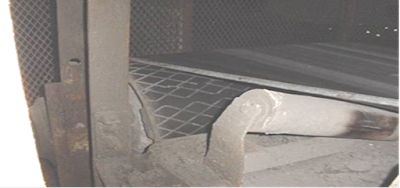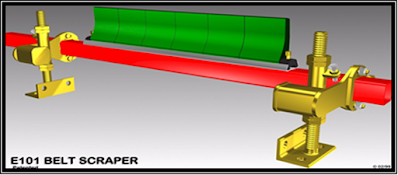INTRODUCTION
In the past rock was transported by means of hand tramming and wheelbarrows, hopper/rail tramming and diesel-powered trucks. This causes a
disadvantage that it takes too long to transport material and was very
exhausting for men to transport by hand. Tramming by rail or trucks is not very
cost effective at all times as roads and railways need to be built etc.
In the modern days we use conveyor belt systems to transport material
from point A to B. It is fast and you get more production and is cost
effective. A conveyor can be described as an endless moving belt on which
material is placed on and move from one place to another.
The ore transported on the conveyor belt systems in mining operations
to the process plants where ore is processed is the revenue that is generated
for the company to run, so if the belt is damaged or stops unnecessarily the
plant cannot process ore from underground. As an operator of a conveyor belt, it
is of importance that you understand and carry out your duties /
responsibilities to the best of your ability.
DUTIES OF THE BELT OPERATOR:
Adhere to:
1) Starting and stopping procedures
2) Break down procedures
3) Lockout procedures
4) Special instructions
GENERAL DUTIES:
a) Ensure that all safety devices are in good
working order and report any
deficiencies
b) Check for loose, sticking damaged idlers.
c) Remove any obstruction’s that is in the way of the belt and its
components or any obstruction that may cause damage to the conveyor belt.
d) Check condition and operation of the belt scrapers.
e) Check or spillage of material; and built up at the chutes, return
idlers, tail pulley, and head pulley along the length of the conveyor and under
the belt on the return side.
f) Check for any damage to the belt itself.
g) Loading to be on the center of the belt and during operation.
h) Check that no part of skirts or chutes is in contact with the belt
unless it is designed like that.
i) Any equipment at loading stations (tip) not working properly to be
reported to the maintenance staff.
CONVEYOR BELT SYSTEM:
COMPONENTS:
1) A belt to carry the material and transmit the pull.
2) A driving unit to transmit the power to the belt.
3) Idlers and supporting structure (stringers and decking plates)
between the head and tail pulley.
5) Accessories that include devices for maintaining belt tension,
loading, unloading and arrangements for cleaning and protecting belt.
BELT DESCRIPTION:
a) The belt is made up of layers of rubber and canvas
b) The belt is covered with a hardened rubber
c) When the belt tears, it can be repaired:
d) With Belt Clips
e) By Splicing
DRIVERS:
On both horizontal
and incline belt conveyors we make use of electric motors as a power source.
The power from the motor is transmitted to the drive pulley by means of
reduction gearboxes with suitable gear ratios. The motor and the drive pulley
are coupled by means of different types of couplings. Gearboxes are used to reduce the speed and
increase the power of the motor.
Horizontal conveyor
belt requires less power than incline conveyors. That is why horizontal conveyor
belts are driven by one head drive pulley and incline more complex. Tandem
drives normally situated at a point along the length of the belt. Tandem drives
means that two drive pulleys are used on the same belt, either driven by two
identical drive units.
COMPONENTS:
HEAD PULLY:
TAIL PULLY:
LAGGING:
Lagging is situated
on a conveyor pulley. It is rubber that is fitted around the pulley to give a
better grip to the conveyor belt.
SNUB PULLY:
The snub pulleys are positioned so that they facilitate the return of
the conveyor belt directly below the deck plates for safety reasons and the
purpose is to deflect belt.
ANOTOMY OF THE PULLY:
TROUGHING & RETURN IDLERS:
The troughing idlers are design to ensure that the conveyor belt forms
a ‘u’ thus allowing the optimum amount of rock to be moved with the least
amount of spillage. The return idlers are installed to support the return belt.
BELT TENTIONING DEVICE:
In order to drive a conveyor belt with a full load, the belt must be
under optimum tension to prevent it from slipping on the drive pulley. The
ideal tensioning device should possess the following features:
a) It must be capable of applying equal tension across the width of the
belting.
b) It should apply tension gradually.
c) In the event of the load on the belt varying, the applied tension
should be capable of correspondingly increasing or decreasing.
d) The actual value of the applied tension should be known, thus
preventing overstressing of the belting.
e) It should automatically take up any slack or stretch in the belting.
f) An automatic gravity take-up tensioning device is the only
tensioning device which has all the desirable features mentioned above. This
device consists of a weighted loose pulley introduced into the return side of
the conveyor belt at some point. The best position for this device is
immediately behind the driving drum.
CHUTES:
The side of the feed chute onto the conveyor is provided with skirt
plates to prevent rock spillage and to centralize the load onto the center of
the belt.
Ore is discharged
through a chute onto a conveyor at a considerable velocity. This movement of
ore can cause damage to the sides of the chutes. Liners are fitted to the chute to prevent
this damage.
Chutes are used to discharge ore from one conveyor onto another. Using a dead
box design reduces the impact of the moving ore. The ore (burden) collection
reduces the possibility of chute damage.
BELT CLEANING DEVICE
/ SCRAPER:
Belt scrapers are normally mounted adjacent to the head pulley and
consists of a rubber blade. Pivoted with a counterweight to maintain pressure
between the blade and the belt. The bolts are most of the time be adjusted on
belt scraper by artisan. Care should be taken that the scraper blade is held
against the belt surface with only sufficient pressure to remove the material.
To prevent excessive wear on conveyor belts, pulleys and idlers, it
is essential to clean the belt after
it has moved around the head pulley and discharged its load.
WATER SPRAYS:
Water loosens and washes the fines sticking to the underside of the
belt by being sprayed onto the belt’s surface before wiping with a rubber
scraper, which assists in releasing the materials from the belt surface.
DECKING PLATES:
Decking plates fitted between the top and the return of the belt will
catch spillage of excess material from the top run. Decking is normally
installed over the entire length of the belt but is especially desirable at the
loading point.
METAL
DETECTORS:
A metal detector is a device that will locate tramp iron, even if it is
buried under ore or other materials, or through a conveyor. The metal detector consists of metal frame
mounted on the conveyor frame under the loaded conveyor. When tramp metal
passes over the metal detector, it will stop the conveyor and activate the
powder marker and siren so as to alert the attendant. The attendant will then
locate the metal and remove it from the conveyor. He will then restart the conveyor belt. Only
found at plant conveyor systems.
INSTRUMENTS:
Weightometers are
installed on to a conveyor belt. Weightometers serve to account for material
travelling on the conveyor belt system; it registers the total weight of
material passing over it, as well as the reading of the tons per hour at any
given time. The Weightometers can be linked to a computer system in the control
room on the shaft.
TACO METER:
The Tacho meter measures the speed of the conveyor belt and anti-slip
detecting device that protects the belt against slip.





















Comments
Post a Comment